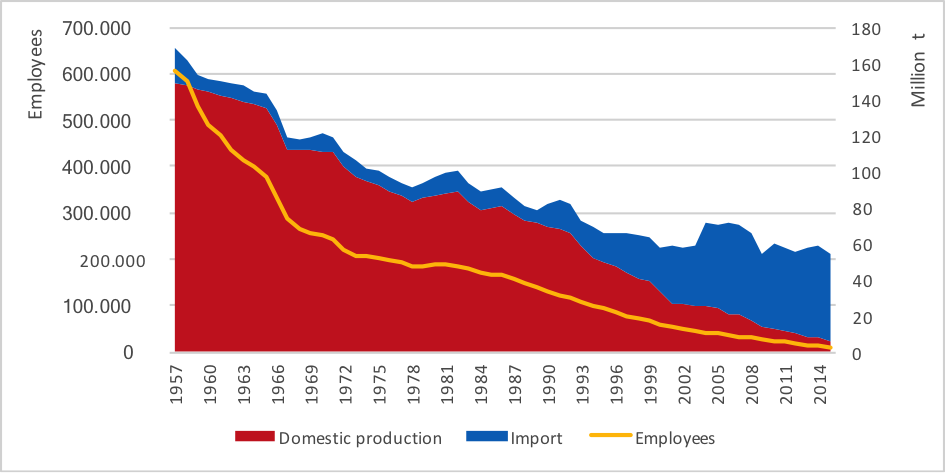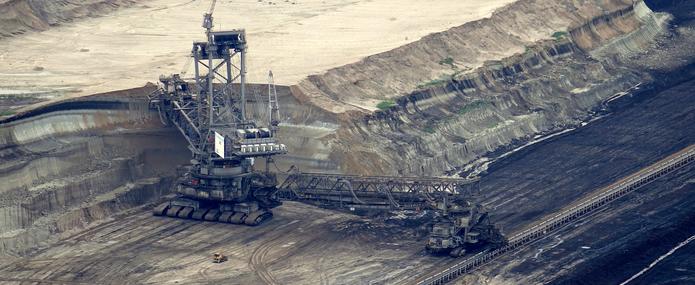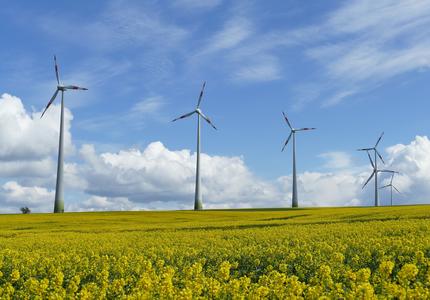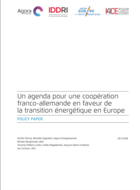A real thorn in the side of the German energy transition, the persistence of high levels of coal-fired power generation is one of the reasons the country is set to miss its target of reducing emissions by 40% from 1990 levels by 2020. Having long been difficult to address at the policy level, the development of a coal phase-out strategy is gaining momentum in Germany with the establishment of a dedicated national commission, mandated by the government to define a socio-economic strategy and a date for coal phase-out by November.
Climate targets missed
In recent years, Germany has established itself as a champion of the energy transition through the massive development of renewable sources of electricity, which increased from 14 to 33% of the power generation mix between 2007 and 2017. However, its international leadership conflicts with the lower than expected reduction in its greenhouse gas emissions, from 973 to 905 MtCO2eq. per year (68 MtCO2eq, or -7,5 %) over the same period 2007-2017, compared to a national target of 751 MtCO2eq by 2020, which is now unachievable. In its Climate Protection Report 2017 [PDF-145 pages], the most recent government projections acknowledge this, and estimate that Germany is heading towards a 32% reduction in its emissions by 2020 relative to 1990 levels, compared to an initial target of 40%.
Le poids persistant du charbon dans la production d’électricité (37 % du mix électrique en 2017) est identifié comme l’une des causes principales de ce retard
The persistent weight of coal in electricity generation (37% of the energy mix in 2017) is identified as one of the main causes of this gap. It is explained by the competitive price of hard coal on international markets and by the fact that the CO2 price on the EU ETS is too low, and does not force coal-fired power plants to reduce their output. This situation is changing—prices are increasing—but not enough to reduce the share of coal to the extent necessary to meet Germany’s climate targets. The climate action plan adopted in November 2016 shows that the energy sector needs to reduce its emissions by 61 to 62% by 2030 to enable Germany to meet its overall target of -55% by 2030. For the electricity sector, this implies halving coal-fired power generation and accelerating renewables, as indicated by a recent study by IDDRI and the German think tank Agora Energiewende.
Achieving such a reduction through the CO2 price implies that it must exceed 50 €/tCO2 (which is far from the levels anticipated further to the recent reform of the EU ETS), but it also means organising the social, territorial and economic redevelopment of domestic coalfields in traditional industrial lignite production regions.
A “carbon commission” at the interface between economic, climate and social challenges
To address these multiple challenges, a dedicated commission has been set up with the goal of building consensus between stakeholders on the pathway towards coal phase-out. This “Commission on growth, structural change and employment”, which met for the first time on June 26 and whose final recommendations are scheduled for late 2018, is mandated by the government to establish a realistic decarbonisation pathway for this sector. It involves a broad panel of 31 members representing different stakeholders: ministries, MPs, unions, companies, representatives of the regions concerned and environmental protection organisations. Its goal is to develop a general approach and specific plans to manage the end of coal production in the mining areas, to propose an end date for coal-fired electricity generation and short-term measures to reduce “as far as possible” the gap with the 2020 climate target, while respecting Germany’s 2030 target. Over and above the climate challenge, it is the economic and industrial future of the mining areas that must be anticipated; Germany still produces lignite (in North Rhine-Westphalia, Lusatia and Saxony) and hard coal (in the Ruhr), propped up by State subsidies. The Commission’s mandate highlights the economic and employment conditions that should be guaranteed in these areas “at the same level as in the rest of Germany”.
Coal phase-out in the interest of stakeholders?
Irrespective of climate policy, the facts suggest that coal phase-out is inevitable for these regions, and that an agreement could be in the interest of several key stakeholders. For example, German coal mining in the Ruhr is currently uncompetitive at the economic level and can only be maintained through an exemption from EU legislation on state aid granted to uncompetitive mines during a transition period that expires at the end of this year. The regions in which the lignite mines are situated are already experiencing population and economic decline and are unable to retain their young people because of a lack of employment prospects and infrastructure, as well as the high level of local pollution. For these regions, the promise of financial support from the German federal government to invest in economic diversification in these regions could contain a very welcome recovery plan.
Where mining jobs are concerned, the challenge does not seem insurmountable either. First, the three above-mentioned lignite mining regions currently employ around 20 000 people, with a relatively high age structure - see the report Coal phase-out, Start now [PDF-53 pages]: 30% of these workers will be 60 or older by 2020, and two thirds by 2030. A progressively managed transition over the next 10 to 15 years could take advantage of the retirement of these workers to limit the need for retraining or redundancies. It would also be in the interest of these workers to have a clear outlook regarding the evolution of the coal industry in Germany. And this transition is not the first or even the largest in numerical terms (Figure 1): the number of mining jobs in the Ruhr region, for example, fell from 600 000 to 190 000 between 1957 and 1977.

Source : DIW Berlin, Coal Transitions. Calculations by DIW Berlin according to Coal industry statistics (2017) and the Association of coal importers (2017)
In order to strike a balance from the viewpoint of the energy sector as a whole, the electricity system needs to evolve alongside coal phase-out, at the same pace. In terms of production, the direction is clearly set by the new coalition agreement: accelerating the development of renewables to reach 65% of electricity consumption by 2030 compared to the previous target of 50%. The Federal Network Agency has been reassuring, recently announcing that half of the current 47 GW of coal-fired power plant capacity could be shut down by 2030 without any risk to supply, while noting that this is dependent on the implementation of grid expansion plans. Germany could also draw on the solidarity of the interconnected European electricity system to pool power generation and flexibility resources in order to manage periods of peak demand on the network, and to do so will need to integrate the changes planned by its European neighbours into its coal phase-out strategy.
A challenge not only for Germany, but also for the European Union
The debate on coal phase-out in Germany is a difficult and critical test: failure would be a negative signal for the credibility of EU climate mitigation policies as well as for the other major coal-using economies. However, the review of the main stakeholders and of the socio-technical conditions for coal phase-out shows that an ambitious agreement is possible.[1]
Coal phase-out is a necessary condition to lend credibility to the climate commitments made by Germany, which recently signed a declaration "Common statement on the long-term strategy and the climate ambition of the EU [PDF- 2 pages] with 13 other Member States to achieve carbon neutrality in Europe by 2050. And once the carbon strategy is determined and agreed, Germany could fully engage in the implementation of the EU energy transition with its neighbouring countries. The recent creation of an interministerial working group between Germany and France, which is actively promoting a carbon price at the regional level for electricity generation, is a positive signal in this respect.
[1] The goal of the Coal Transitions project (co-ordinated by IDDRI and Climate Strategies) is to analyse historical, current and possible coal phase-out pathways for some of the world’s most coal-dependent countries. Several national case studies (forthcoming) explore the conditions for this transition and its feasibility.






